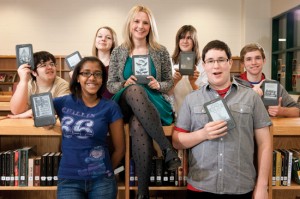 We’ve been hearing a lot lately about the trouble public libraries can find themselves in if they make the mistake of purchasing tablets or e-readers that aren’t accessible to the disabled. Both the Sacramento Public Library and the Free Library of Philadelphia, for instance, have become the subject of lawsuits as a result of their non-accessible Nook e-readers.
We’ve been hearing a lot lately about the trouble public libraries can find themselves in if they make the mistake of purchasing tablets or e-readers that aren’t accessible to the disabled. Both the Sacramento Public Library and the Free Library of Philadelphia, for instance, have become the subject of lawsuits as a result of their non-accessible Nook e-readers.
Some public schools, of course, have ended up in similar situations. It seems to me that a fairly obviously hole exists in the e-reader marketplace at the moment, and it’ll be interesting to see if a e-reader manufacturer eventually steps forward to create an all-accessible device. Honestly, that would come as a surprise to me, since a relevant software program–for Android tablets, say–could probably be produced a lot quicker, and for much less money.
Earlier today, Good E-Reader posted an interesting piece about this very problem; it’s titled, “The Vision Problem – Why eReaders Are Not Widely Adopted in Public Schools.” Here are a few of the opening lines from that piece:
“The Amazon Kindle and many other e-readers continue to enjoy unbridled success in the retail sphere, but have not caught on in educational institutions. The main reason is not the cost of the hardware or being locked into a particular ecosystem, but the device being capable of addressing disabled people’s needs. Amazon has made great strides in the last few years to make its e-readers accessible to the blind and dyslexic. Other companies have invested zero effort into their devices being more user friendly with ALL students.
“The big reason why many school boards in the USA and across the world have not adopted e-readers in the classroom is because whenever they try, advocacy groups representing disabled people shut them down. If a device cannot be used by all students or a strong majority of the population, they are considered not a viable investment of the school’s money and alienates specific students.”
































Amazon may have been supportive of the disabled in the past; however the new generation of Kindle e-readers (Paperwhite) have no sound capabilities at all. No spoken menus. No text-to-speech. I think this is a huge backwards step.
This might explain the relatively greater interest of K-12 and Higher Education in the Apple iPad but I think that there is much more to that interest than compliance with accessibility standards. One can read more about iPad accessibility here” http://www.apple.com/accessibility/ and it’s an impressive offering.
Educators really want and need to get the biggest return per dollar on any investment in educational technologies and there’s so much more to a modern curriculum than reading text. Investing in a single purpose device, though with a lower per unit cost, simply doesn’t promise a commensurate return in educational outcomes.
There is an accessible book reader called the jetbook color, i know because i own one and so does my friend. I have enough vision left to read and write but it is very difficult sometimes and i struggle. The jetbook has voice commands, can read a book to me and can voice a word i select from it. It is a tad pricy but very worth it. The company gave me a discount so it would not hurt to ask.
Hmm it appears like your website ate my first comment (it was extremely long) so I guess I’ll just sum it up what I wrote and say, I’m thoroughly enjoying your blog.
I too am an aspiring blog writer but I’m still new to the whole thing. Do you have any suggestions for newbie blog writers? I’d definitely appreciate it.